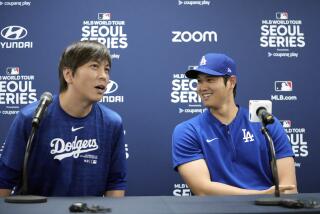Bridging the Business Communication Gap With the Japanese : Protocol: U.S. executives who do business with the Japanese are discovering that using an interpreter is not enough. They’re turning to “cross-cultural” consultants.
- Share via
As little as four years ago Louis Shoemaker, administration director of Nissan’s U.S. design center, would dread the regular visits of Japanese managers and engineers who flew to San Diego from the automobile giant’s research and development center near Tokyo.
Language barriers alone caused headaches, Shoemaker said, but different styles of doing business--stemming from cultural differences--made pitching American automobile designs to the stoical Japanese a difficult task.
“If we proposed a design that they didn’t like or asked them for something, instead of saying that they didn’t like it or couldn’t do it, they would say, ‘We will study it,’ ” Shoemaker said. “That was their polite way of saying no to us, but we really thought they would study it and get back to us.
“As you can imagine, it was upsetting when we got no response,” Shoemaker said.
Problems like this led Shoemaker to call in “cross-cultural” consultant Yukari Ohnishi to help improve communication by bridging the cultural differences between the two groups. Ohnishi and consultants like her try to help Japanese and Americans understand the others’ customs, values and protocols. Such understanding, Ohnishi says, creates a less stressful, more productive work environment.
Indeed, Shoemaker and other American executives who are increasingly seeking and doing business with the Japanese these days are discovering that using an interpreter alone is hardly enough to communicate effectively. That’s why more Americans are turning to consultants like Ohnishi.
In addition to Nissan Design International, Ohnishi has worked for the U.S. subsidiary of computer manufacturer Fujitsu Ltd. of Tokyo; Hensel Phelps Construction Co., which recently built a 400-room Sheraton hotel in San Diego for a Japanese developer, and Luce, Forward, Hamilton & Scripps--one of San Diego’s largest law firms, which has several ties to the Japanese.
The services of cross-cultural consultants are valuable, Americans say, because the meaning of an apparently simple communication is often lost in literal translation. Moreover, Westerners say they are finally realizing that Japan’s long history and deep-rooted traditions have shaped a unique way of thinking--an approach that is often completely foreign to Americans.
To better understand this approach, Ohnishi met regularly with the design center’s 30-member staff and lectured on several topics, including the Japanese work ethic, customs and values for nearly a year. Ohnishi also encouraged the staff to “role-play” and re-enact tension-creating encounters with the Japanese as a means to vent their frustrations and prevent the recurrence of such scenarios.
“At times, we thought of her as our shrink,” Shoemaker said. And in time, he added, the cultural gap was narrowed.
“We began to understand the reasoning behind the Japanese’s actions,” Shoemaker said. “That doesn’t mean we necessarily liked what they did, but at least we understood why they were doing it. That alone eased the tension.”
Fostering such understanding is what Ohnishi tries to provide her clients. But often, she says, American businessmen--hungry for immediate financial gain--come to her for a “quick fix.”
“They’ll come in and say, ‘We’re going to Japan next week. Can you come in and talk to us for two or three hours?’ ” Ohnishi said.
“The biggest problem with these people is that although they come asking for help, they think they know what they have to learn,” she said. “They don’t really want to learn about culture--they want to know whether they should bow or shake hands.”
Etiquette serves an important function in business meetings, Ohnishi said, but its value is overemphasized by Americans. According to Ohnishi, success with the Japanese depends on whether Americans can recognize the many differences between them. So in initial meetings with new clients, Ohnishi points out the differences.
“The first thing Americans want to do is find out how profitable a project will be and how soon,” Ohnishi said. “But on the other hand, the Japanese want to determine if they can trust you.”
Although values such as trust and loyalty are valued in the West, Ohnishi says, they are appreciated to an even greater degree in Japan. Besides being valued in society, such traits are demanded of the Japanese in the corporate community. For example, intense loyalty is fostered among the Japanese, Ohnishi said, because unlike Americans who often work for different employers in pursuit of career advancement, the Japanese can spend their entire careers with one company.
“They want to know whether you can weather the storm when things take a turn for the worse,” Ohnishi said, “or whether you’re going to run.”
Even after the Japanese find compatible Americans, U.S. negotiating teams often ruin their chances for doing business by using what Ohnishi calls “the John Wayne approach.”
“One of the biggest problems with American negotiating teams is that each member often wants to be his own master,” Ohnishi said. “He wants his own visibility and as a result won’t put the group interest in front of his own.”
On the other hand, Ohnishi said, the same Japanese business culture that demands loyalty also fosters cohesiveness and makes the Japanese disdain “one-upmanship.”
Although Ohnishi wants her American clients to work independently with the Japanese eventually, she will, at times, sit in on negotiations.
John W. Brooks, a senior partner at Luce, Forward, Hamilton & Scripps and chairman of its international services group, is a veteran when it comes to dealing with the Japanese. But Brooks is the first to admit that his early meetings with the Japanese left much to be desired.
“There were plenty of occasions, both here and in Tokyo, where I was involved in meetings where I thought I was doing one heck of a job,” Brooks said. “But in fact I wasn’t.
“For example, while I was talking, I would see my Japanese counterpart nodding his head up and down,” Brooks said. “Like any Westerner, I assumed that he was agreeing with me. Well, that’s not true. The fact that he was nodding just meant that he heard what I was saying.”
That’s why Brooks invited Ohnishi to attend a few of his meetings.
“She’s a cultural guide, an extra set of eyes and ears, to make sure that understanding is being given and received between the two parties,” Brooks said.
“During a break, for example, (Ohnishi) will come up to me and say, ‘You should review points 2 and 7. Mr. Tanaka didn’t say anything, but he really didn’t understand you.’ ”
The Japanese penchant for silence, whether in the negotiating room or in the office, is what Americans point to as the underlying cause for most problems.
“Silence to the Japanese is a medium of communication,” Ohnishi says. “It is not a void as the Americans perceive it.” That difference, for example, can lead to charges by American workers that the Japanese are sexist or unresponsive.
“The American working woman, who these days is looking out for any manifestation of sexism, is very sensitive to perceived slights, such as when her boss doesn’t talk to her. I’ve heard them complain--’Am I invisible or what?’ ”
Beyond the fact that English is their second language, Ohnishi explains that the Japanese executive “doesn’t have it in him to come up and say, ‘Hi, how are you doi”
“Back in Japan, he didn’t have to say anything because he’s had such a great shared history with his co-workers,” Ohnishi said. “They know each other inside and out. They really don’t need to communicate verbally.”
Born near Hiroshima, Japan, Ohnishi first came to the United States in 1966 on a scholarship program and spent a year in Lexington, Mass. In the early 1970s, Ohnishi returned, this time lured by Southern California’s weather and a chance to study at UC San Diego, where she later earned a bachelor’s degree in linguistics.
Chance encounters with Japanese executives gave Ohnishi an opportunity to teach English. And then, in 1981, Ohnishi accepted an offer to teach Japanese to American businessmen at her alma mater. But when her students seemed eager to learn more than the Japanese language, she founded Ohnishi & Associates in 1985.
“That’s when I realized that just teaching the verbal aspect wasn’t enough for communication,” Ohnishi said.
“My goal is to make my clients less dependent on me,” Ohnishi said. “I want them to be able to understand the Japanese on their own and make their own decisions.
“The last thing I want is lot of anxious Americans on my hands,” she added.






